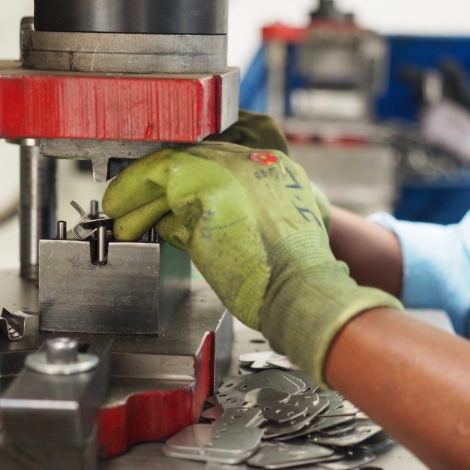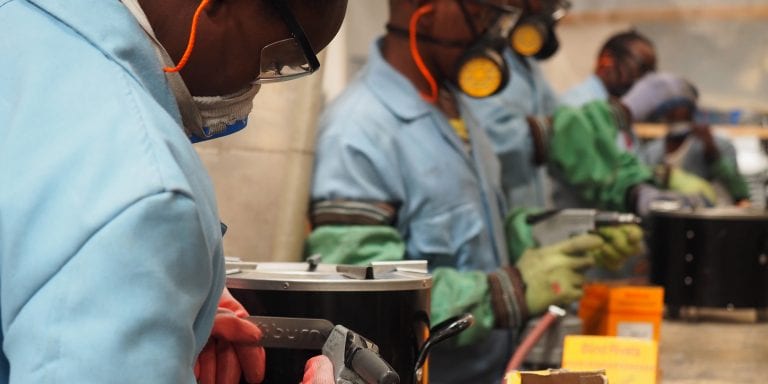The eraser dust has settled, the tablet screen has dimmed, the foamcore models are tossed aside on the floor in a coat closet. It’s been a creative marathon of product design and prototype testing, and now it’s time to produce the first run. Now there is a difficult decision. Where do social businesses that sell basic-needs products in developing countries go to make their wares? Do they put in the time to work with a local manufacturer or even start their own factory in the country where their customers live? Or do they outsource production to China or India or somewhere with the proven capacity to do the job well?
“Two schools of thought compete against one another over the question of local manufacture,” writes Khanjan Mehta, E4C Contributing Editor and head of the Humanitarian Engineering and Social Entrepreneurship program at Pennsylvania State University in an installment of his series, The Big Design Questions. “From one point of view, local manufacturing for nearby local markets with locally available raw materials can lead to resilient businesses.” But local manufacture could cost more, Mehta says.
Further, he adds, “Despite the additional transportation and logistics fees, outsourcing is sometimes necessary to maintain economic sustainability. In situations like these, the venture must accept that all development goals cannot be achieved simultaneously.
“Go local as much as you can, I would say, because you’re not moving huge volumes and you still don’t know if your design is great or not” – Yotam Ariel, Bennu Solar
“For example, KickStart treadle pumps and irrigation systems are manufactured in China due to cost restrictions. Similarly, biomedical ventures like ClickMedix face cost and quality control barriers when trying to manufacture locally.”
Experts we consulted tended to agree that the decision may come down to the type of product and the quantity of production.
“Go local as much as you can, I would say, because you’re not moving huge volumes and you still don’t know if your design is great or not,” says Yotam Ariel, Managing Director of Bennu Solar, which establishes supply chains for custom solar products in China.
Outsourcing the manufacture to China should be a consideration only when a venture is ready to commit at least USD $100,000 to a single manufacturing plant, Ariel says.
For basic manufacturing, it is definitely cheaper in the long run to invest in capital and resources in Africa. Training local talent in operating equipment and processes makes economic sense and should align with a social enterprise’s mission” – Eoin Flinn, BURN Manufacturing
“People think it’s more expensive to produce locally, but if you bring in all of the costs of doing it in China, it’s not,” Ariel says.
True, local manufacture is cheaper at low volumes, but it remains cheaper even at high volumes if the product is not difficult to produce, says Eoin Flinn, the former director of BURN Manufacturing in Nairobi, Kenya, who developed the company’s stove factory from the ground up.
“For basic manufacturing, it is definitely cheaper in the long run to invest in capital and resources in Africa. Training local talent in operating equipment and processes makes economic sense and should align with a social enterprise’s mission,” Flinn says.
On the other hand, the cost of outsourcing includes the profit that a Chinese subcontractor makes, shipping, tariffs and a slower reaction to the market.
“It is important to remember that the manufacturing location is a secondary consideration. The primary goal is to provide products that deliver real value to the target market.” – Introduction to Engineering for Global Development
“This logic applies to stamping, molding, assembly… relatively simple manufacturing. Semi-conductors, PCBA, and complex electronics in general make the argument less tenable,” Flinn says.
Determining a venture’s manufacturing goals can help settle the question, according to the expert advice in the fourth and final module of our online course, Introduction to Engineering for Global Development. Ventures should ask themselves questions such as “Which type of manufacturing will yield the highest quality products?” and “Is job creation a priority?” and others.
But in the end, the location may not be the most important aspect of the venture. As the course states, “The primary goal is to provide products that deliver real value to the target market.”

